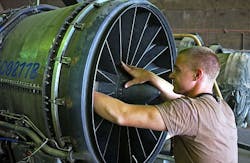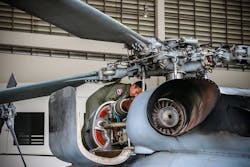U.S. Air Force employs data management and analytics platforms to enhance aircraft MRO
Teradata PARTNERS Conference, Atlanta. The U.S. Air Force is dominating air, space, and cyberspace – as its mission statement indicates – with assistance from big data and data analytics. Air Force officials, data scientists, and other personnel are harnessing advanced data-handling and analytics tools, both software and hardware solutions, to streamline workflows, increase efficiencies and productivity, track and manage assets, and replace scheduled/time-based maintenance with conditioned-based maintenance (CBM) – saving at $1.5 million in one year.
Air Force personnel are under pressure to control aircraft/vehicle maintenance costs while also maintaining combat/mission readiness. Specifics include:
- a budget of roughly $100 billion
- 84 major installations
- 82 minor installations
- more than 6,000 aircraft in the total force inventory
Complicating matters, the Air Force had thousands of operational and analytical systems – a majority of which were stove-piped solutions. Many were standalone, rather than integrated systems. The mission goal, therefore, was to recapitalize and modernize systems and vehicles, describes U.S. Air Force Chief Engineer Larry Potts.
Potts described how U.S. Air Force personnel were harnessing Big Data and data analytics tools to facilitate improved and better-informed maintenance, repair, and overhaul (MRO) decisions in “Taking off with Conditioned-based Maintenance at U.S. Air Force” – a talk delivered at the 2016 Teradata PARTNERS Conference in Atlanta, Georgia.
Air Force engineers selected data management and analytics tools to enable and enhance CBM for Air Force aircraft, landing gear, and myriad other critical systems. Specifically, Air Force officials opted to use Teradata’s Aster platform to better manage:
- Flightline maintenance
- Inventory
- Aircraft depot data
The installation, described as a Proof of Concept (PoC), at Hills Air Force Base in Ogden, Utah, includes:
- Teradata Active Enterprise Data Warehouse 6690 with 6 nodes, 22 terabytes of storage used
- 6-node Aster platform with 2 queens and 4 workers
- 6-node Hadoop platform
- Informatica PowerCenter with 200-plus data feeds (130 inbound, 70 outbound) and 450 workflows
- 39,000 total users, of which roughly 9,500 are highly active
- Rich Internet Apps (RIA) with more than 12,000 users and 26 mission apps
- 400 legacy logistics systems with varying system complexity
Conditioned-based maintenance is a serious concern for any organization that owns repairable assets, according to Potts and co-presenter Mike Durham, senior solution architect, Government Systems at Teradata. “The success of CBM is dependent upon the availability and quality of data within the maintenance repair operations.
“With many operations the data is massive, complex, and multidimensional, making it a perfect challenge for the Teradata Aster platform,” Durham says.
The Air Force’s journey into CBM began with “sourcing, cleansing, and understanding the data all the way through the creation of re-usable models and graphs within Teradata Aster AppCenter,” Potts and Durham explain.
Air Force personnel “overcame the challenges of data quality and relevance as we created meaningful models and graphs,” Potts adds, noting that multiple scenarios and analytic approaches were taken to solve various challenges.
Military aircraft MRO image courtesy Shutterstock.
Sensors installed on various parts of the aircraft/vehicles – including the flight deck (or dashboard in the case of ground vehicles), fuel system, landing systems, etc. – capture data in real time. Various operational and performance parameters are recorded, including miles driven, fuel used, and speeds reached. By analyzing and exploiting the data gathered, personnel are able to track vehicles and monitor vehicle and vehicle system conditions, use, speeds, and more.
Access to this information enables enhanced decision making, helping officials better predict when a maintenance issue or need will arise; predictive analytics enables vehicle equipment specialists to be proactive rather than reactive with MRO activities. Armed with this intel, military leaders are also better able to decide whether it is more cost-effective to maintain, repair, or overhaul an asset or slate the vehicle for retirement (disposal or sale) and replacement. Perhaps most importantly, the system provides real-time vehicle status information, including whether vehicles are mission-ready and -capable.
Lessons learned from the POC installation, as described by Potts and Durham, include:
Subject-matter expert (SME) support is essential
Schedule working sessions with SMEs
Data scientists and business leaders (e.g., flightline maintenance and office personnel) should work side by side
Data analysis uncovers something/patterns; SMEs are needed to pin down exactly what
Have specific use cases in mind, make sure the data is available, and analyze that data vs. the entire database
Biographies
Larry Potts, chief engineer, U.S. Air Force
Larry Potts started his IT career at NCR in 1981. He became involved with Data Warehousing as a Project Manager in 1991 and was a member of the team that deployed one of the first implementations of Teradata on a Unix platform. He participated in numerous data warehousing projects, helping to evolve some initial 'stove-pipe' solutions into corporate 'enterprise' solutions. He was also primarily responsible for defining NCR's EDW architecture and Business Intelligence strategies. Today, Potts is a senior information systems software engineer with MITRE supporting the United States Air Force. Over the last eight years, Potts has helped the program mature their use of data warehousing technology and is helping them move into the world of discovery analytics along with Big Data.
Mike Durham, senior solution architect, Government Systems at Teradata
Mike Durham is a senior solution architect for Teradata in Government Systems with more than 20 years in the IT industry, including working for Mitre Technology supporting U.S. Transportation Command. As a former U.S. Air Force service member, Durham has devoted his entire career to supporting our military. He will soon be completing his Masters in Data Science and has been leading the Conditioned Based Maintenance project at the U.S. Air Force.
Read more about Big Data, the IoT, and cloud computing in aerospace:
- Digitization and data analytics are transforming aerospace and defense organizations
- U.S. Air Force harnesses data analytics tools to streamline, enhance management of 90,000-vehicle fleet
- IoT and aerospace: implications for improvements within supply chain management
- Aerospace and defense organizations reap rewards from Internet of Things
Search the Aerospace & Defense Buyer's Guide
You might also like:
Subscribe today to receive all the latest aerospace technology and engineering news, delivered directly to your e-mail inbox twice a week (Tuesdays and Thursdays). Sign upfor your free subscription to the Intelligent Inbox e-newsletter at http://www.intelligent-aerospace.com/subscribe.html.
Connect with Intelligent Aerospace on social media: Twitter (@IntelligentAero), LinkedIn,Google+, and Instagram.
Intelligent Aerospace
Global Aerospace Technology NetworkIntelligent Aerospace, the global aerospace technology network, reports on the latest tools, technologies, and trends of vital importance to aerospace professionals involved in air traffic control, airport operations, satellites and space, and commercial and military avionics on fixed-wing, rotor-wing, and unmanned aircraft throughout the world.

Courtney E. Howard | Chief Editor, Intelligent Aerospace
Courtney enjoys writing about all things high-tech in PennWell’s burgeoning Aerospace and Defense Group, which encompasses Intelligent Aerospace and Military & Aerospace Electronics. She’s also a self-proclaimed social-media maven, mil-aero nerd, and avid avionics and space geek. Connect with Courtney at [email protected], @coho on Twitter, on LinkedIn, and on Google+.



